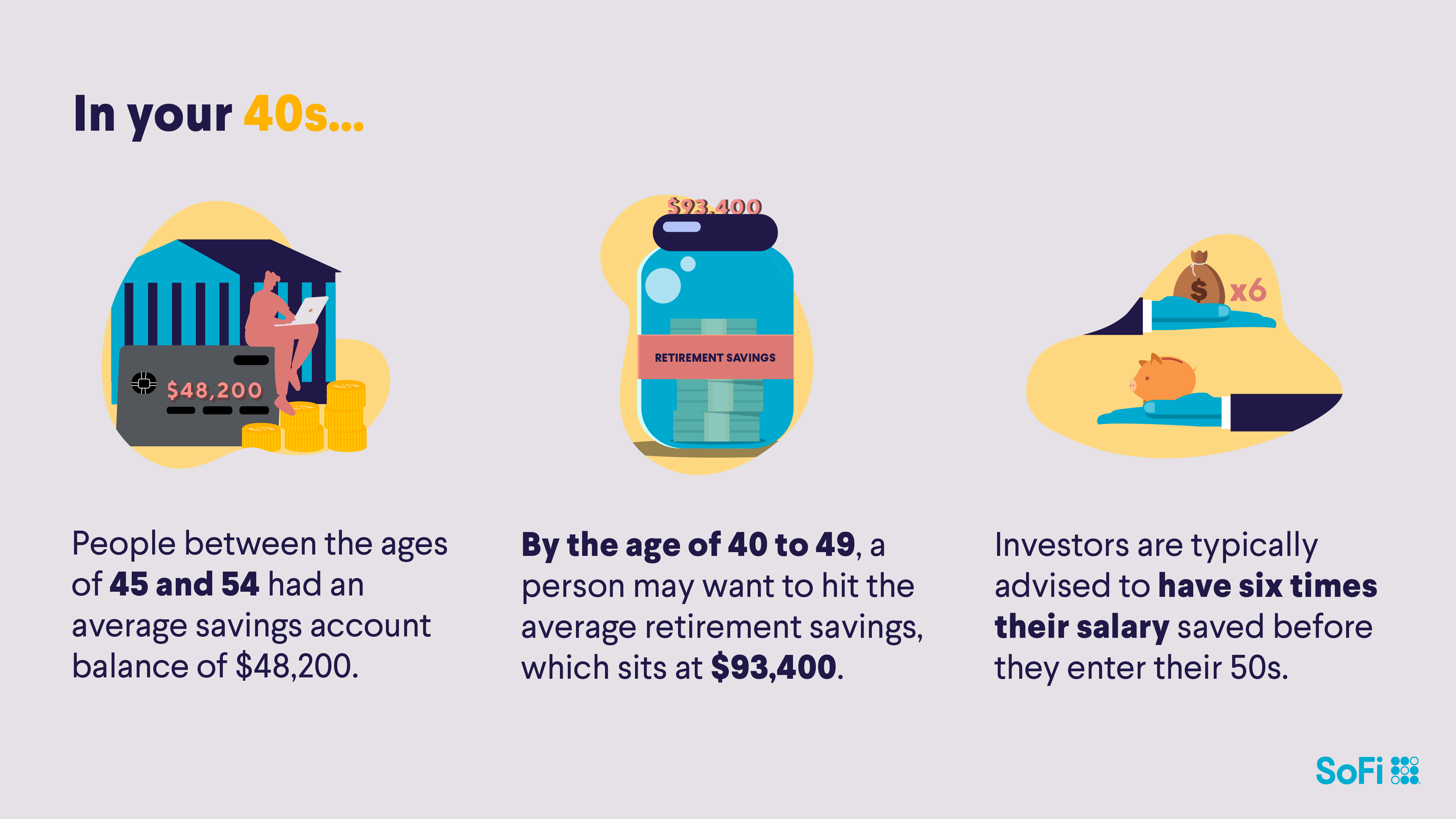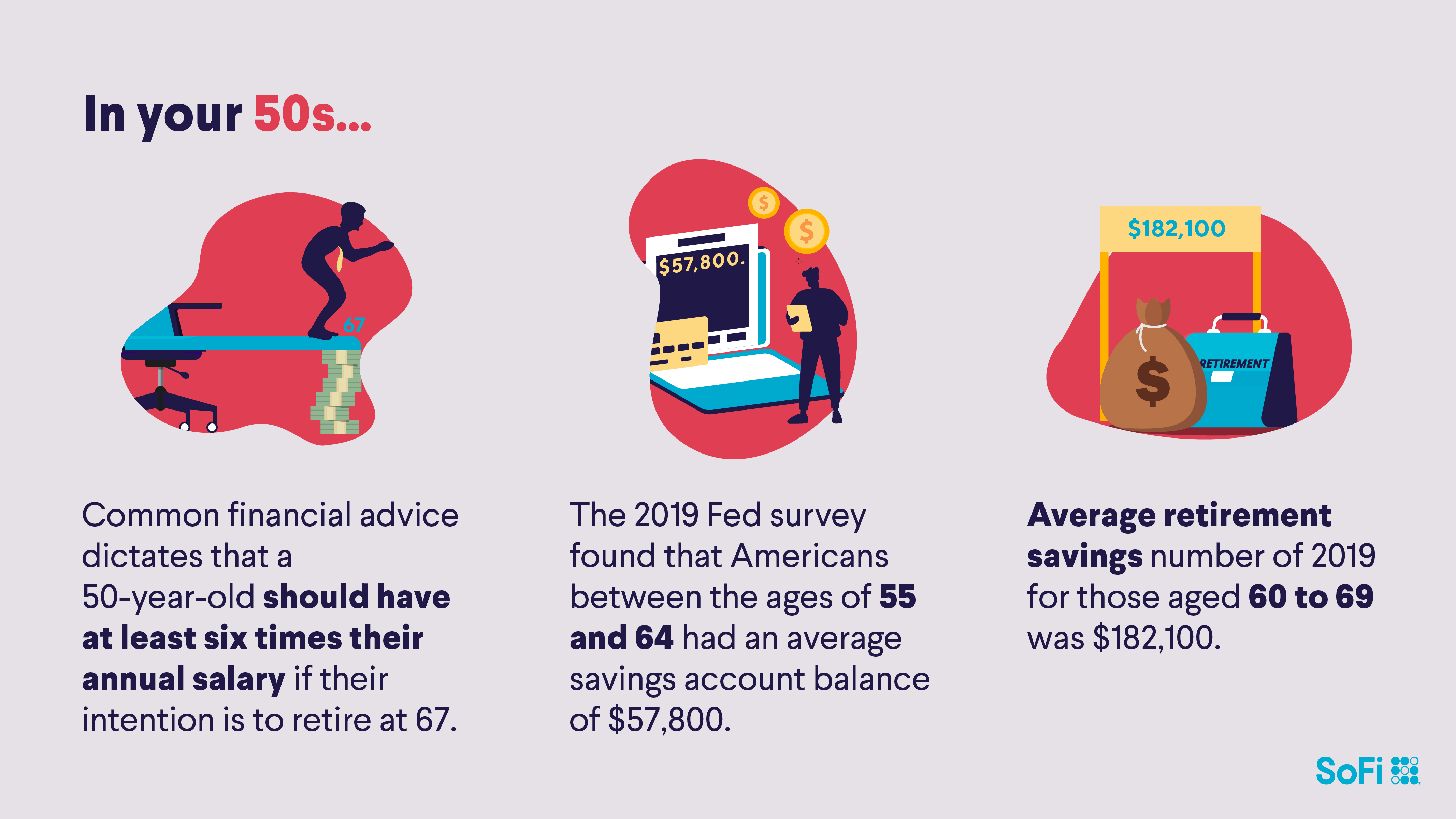Guide to the Average Savings in America by Age
Table of Contents
How much does the average American have in savings? Age tends to have a lot to do with it. Generally, as people get older, they are likely to have more savings.
But what the average person has in a savings account also depends on their financial goals and personal circumstances.
If you’re looking for a benchmark of just how much you should save by a specific age, or how much you should start contributing right now, read on for average savings by age and some tips that could help.
Key Points
• The average savings for individuals under 35 is $11,200.
• Individuals between the ages of 35 and 44 have an average savings of $27,900.
• Those aged 45 to 54 have an average savings of $48,200.
• The average savings for individuals between 55 and 64 is $57,800.
• Individuals aged 65 and older have an average savings of $60,400.
The Importance of Saving for the Future
Life can happen fast. For example, the average cost of having a new baby can run parents approximately $3,000 in out-of-pocket expenses for pregnancy and delivery. And then there’s the cost of caring for a child, which some estimates put at more than $18,000 for raising them through age 17.
And, if that baby wants to get a college degree, you’re looking at a whole new realm of savings. The cost of a college education can range from about $44,000 to well past $150,000.
There’s one other big reason to save for the future: People are living longer. According to a 2023 survey by the Employee Benefit Research Institute, only 18% of American workers are “very confident they will be able to retire comfortably.” Four in 10 workers say their lack of confidence is because they have little to no savings.
💡 Quick Tip: Did you know that opening a brokerage account typically doesn’t come with any setup costs? Often, the only requirement to open a brokerage account — aside from providing personal details — is making an initial deposit.
A Savings Shortfall
More than half of Americans can’t cover an unexpected $1,000 expense, according to Bankrate’s 2023 emergency savings report. Only 43% say they could cover it.
And 37% of all Americans don’t have enough cash in savings to cover even a $400 emergency, the Federal Reserve found in its “Economic Well-Being of U.S. Households in 2022” report.
Recommended: Try our emergency fund calculator to see how much you should save for an emergency fund.
Get a 1% IRA match on rollovers and contributions.
Double down on your retirement goals with a 1% match on every dollar you roll over and contribute to a SoFi IRA.1
1Terms and conditions apply. Roll over a minimum of $20K to receive the 1% match offer. Matches on contributions are made up to the annual limits.
Average Savings by Age in the USA
The Fed’s latest Survey of Consumer Finances shows that the typical American household has $5,300 in a savings account at a bank or credit union. But this number varies greatly by age and number of people in a household. Here’s what savings by age looks like.
Average Savings for Those 35 and Younger
Americans under the age of 35 had an average savings account balance of $11,200, according to the Fed’s survey.
This is a large age bracket that can range from those just graduating high school to recent college grads to young professionals well into a decade’s worth of work.
It’s wise to have three to six months of expenses in an emergency fund. At the very least, aiming to have $1,000 handy in a savings account for unexpected expenses is recommended.
For those who have started their careers, employer-sponsored retirement funds such as an IRA or a 401(k) can be good options to start saving for long-term retirement goals.
It makes sense to contribute at least enough to get matching funds from an employer, if that’s an option with your company’s plan. For reference, the average 401(k) savings for someone between the ages of 20 and 29 in the Fed’s survey was $10,500.
Recommended: Why You Should Start Retirement Planning in Your 20s
Average Savings by Age: 35 to 44
Americans between the ages of 35 and 44 had an average savings account balance of $27,900, according to the Federal Reserve Survey of Consumer Finances. Those in this age bracket are now well into adulthood. At this stage of life, it’s prudent to have that three-to six-months’ worth of savings in an emergency fund, to cover the cost of everything from an accident to a lost job.
This may also be the time to think about diversifying a financial portfolio and possibly investing in the stock or bond market.
And, of course, keep contributing to your 401(k). For reference, the average 401(k) savings for someone between the ages of 30 and 39 was $38,400.
Average Savings by Age: 45 to 54
People between the ages of 45 and 54 had an average savings account balance of $48,200, according to the Fed’s survey.
At this point, general financial advice dictates that a 50-year-old should have at least six times their annual salary if their intention is to retire at 67.
And by the age of 40 to 49, a person may want to have the average amount of retirement savings, which sits at $93,400.

Average Savings by Age: 55 to 64
The Fed survey found that Americans between the ages of 55 and 64 had an average savings account balance of $57,800.
Since this is the time when most Americans are staring down retirement in a few years, it’s generally a good idea to boost retirement savings into high gear.
That’s because while younger people in 2024 are capped at contributing $23,000 a year to a 401(k) account, those age 50 and up are allowed to contribute an additional $7,500.This is known as a catch-up contribution.
For 2025, those under age 50 can contribute up to $23,500, and those 50 and up can contribute an additional $7,500. Also for 2025, those aged 60 to 63 may contribute an additional $11,250 instead of $7,500, thanks to SECURE 2.0.
The average retirement savings account for a person between the ages of 50 and 59 is $160,000. It’s important to note that taking a withdrawal from such a plan before the age of 59 ½ could mean tax penalties.

Average Savings by Age: 65 and Older
This is when savings really peaks for the average American. The latest Federal Reserve Survey of Consumer Finances found that Americans between the ages of 65 and 74 had an average savings account balance of $60,400.
However, that savings number does drop over time. According to the survey, Americans above the age of 75 had an average savings account balance of $55,600.
This underscores the importance of creating a retirement budget and sticking to it in order to have enough savings for as long as needed.
But before retirement, try to hit the average retirement savings amount for those ages 60 to 69, which was $182,100.
This chart offers an at-a-glance comparison of the average American savings by age.
| Age | Average savings |
|---|---|
| Under 35 | $11,200 |
| 35-44 | $27,900 |
| 45-54 | $48,200 |
| 55-64 | $57,800 |
| 65+ | $60,400 |
💡 Quick Tip: How to manage potential risk factors in a self-directed investment account? Doing your research and employing strategies like dollar-cost averaging and diversification may help mitigate financial risk when trading stocks.
Median Savings by Age
Median savings is different from average savings. The median is the number in the middle of all the other numbers, meaning half the numbers are higher and half are lower. So with median savings, half the people in an age category will have saved more and half will have saved less.
These are the median savings by age, according to the latest Federal Reserve Survey of Consumer Finances:
• Under 35: $3,240
• 35-44: $4,710
• 45-54: $5,620
• 55-64: $6,400
Savings vs Retirement Savings
What Americans have saved for emergencies, expenses, and other near-future goals is different from what they have in their retirement savings accounts, as you can see from all the information above. And it’s critical to have both types of savings at the same time.
And keep this in mind: As you get older, and closer to retirement, it’s important that your retirement savings grow even more. It’s a good idea to contribute the maximum amount allowed to your retirement accounts at this time, if you can. This is one of the ways to save for retirement.
Recommended: Average Retirement Savings By State
Saving a Little Bit More
Reaching specific savings goals doesn’t have to be complicated. It just means doing a bit of homework, strategizing, and staying diligent about personal finances.
The first step in saving more is to analyze current expenses to see what can be cut back on or cut out altogether to make more room for saving. This means creating a monthly personal budget and tracking current personal spending.
To track spending, a person could create an excel spreadsheet and list all expenditures by categories like groceries, phone bill, car expenses, housing, medical, entertainment and others over the course of a month, filling it in with every single dollar spent to see where the money is going. Or you can use an online tracker like SoFi, which allows users to connect all their accounts to one dashboard and track spending habits in real time.
After the month is up, the next step is to look back on the expenditures list. Was there anything that surprised you? Do you need all those streaming subscriptions? How about that gym membership — did it actually get used? This is the time to get a little ruthless.
After figuring out what’s left, try implementing a general financial outline like the 50/30/20 rule. This means that approximately 50% of your after-tax income goes toward essential expenses like food and rent, while 30% goes toward discretionary expenses like nights out at the movies or concerts. The last 20% belongs to savings and retirement account goals.
Next, it’s time to get creative about saving even more for the future. This can be done by putting more cash into a savings or retirement account via direct deposit right from a paycheck.
Those looking to save a few more bucks every month could also do so by getting rid of unnecessary expenses. But, instead of pocketing that cash, consider using mobile deposit to direct that cash right to savings.
Still feeling the pinch and don’t really have room to save more from a budget? Working part-time for, say, a ride-sharing company could allow you to set your own hours and earn extra income based on how much time you can dedicate to it. Other options might include freelance work in photography, writing, or other creative arts.
Saving and Investing With SoFi
Along with all these savings strategies to help put away extra money, investing for your future goals is also important to help your money grow.
For instance, you may want to consider setting up an investment account. Investing a little now could go a long way in saving for tomorrow, next year, and your life after retirement.
Ready to invest in your goals? It’s easy to get started when you open an investment account with SoFi Invest. You can invest in stocks, exchange-traded funds (ETFs), mutual funds, alternative funds, and more. SoFi doesn’t charge commissions, but other fees apply (full fee disclosure here).
FAQ
How much should a 30 year old have in savings?
By age 30, you should have the equivalent of your annual salary saved. So if you make $60,000 a year, you should have $60,000 in savings.
How much money does an average person have in savings?
The average American has $65,100 in savings, according to a 2023 study by Northwestern Mutual.
How many Americans have $100,000 in savings?
According to one 2023 survey, only 14% of Americans have at least $100,000 in savings.
Third-Party Brand Mentions: No brands, products, or companies mentioned are affiliated with SoFi, nor do they endorse or sponsor this article. Third-party trademarks referenced herein are property of their respective owners.
Financial Tips & Strategies: The tips provided on this website are of a general nature and do not take into account your specific objectives, financial situation, and needs. You should always consider their appropriateness given your own circumstances.
SoFi Invest®
INVESTMENTS ARE NOT FDIC INSURED • ARE NOT BANK GUARANTEED • MAY LOSE VALUE
1) Automated Investing and advisory services are provided by SoFi Wealth LLC, an SEC-registered investment adviser (“SoFi Wealth“). Brokerage services are provided to SoFi Wealth LLC by SoFi Securities LLC.
2) Active Investing and brokerage services are provided by SoFi Securities LLC, Member FINRA (www.finra.org)/SIPC(www.sipc.org). Clearing and custody of all securities are provided by APEX Clearing Corporation.
For additional disclosures related to the SoFi Invest platforms described above please visit SoFi.com/legal.
Neither the Investment Advisor Representatives of SoFi Wealth, nor the Registered Representatives of SoFi Securities are compensated for the sale of any product or service sold through any SoFi Invest platform.
For a full listing of the fees associated with Sofi Invest please view our fee schedule.
SOIN0723091 Read more




